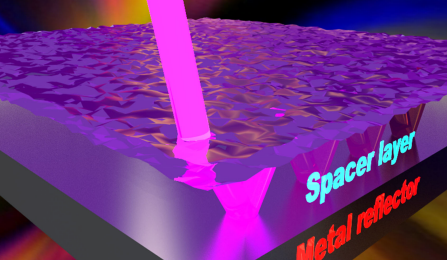 |
| A rendering shows a beam of light interacting with an optical nanocavity. The nanocavity boosts light absorption in ultrathin semiconductors. Credit: Advanced Materials |
By Cory Nealon
Release Date: March 5, 2014
BUFFALO, N.Y. – Associated with unhappy visits to the dentist, “cavity” means something else in the branch of physics known as optics.
Put simply, an optical cavity is an arrangement of mirrors that allows beams of light to circulate in closed paths. These cavities help us build things like lasers and optical fibers used for communications.
Now, an international research team pushed the concept further by developing an optical “nanocavity” that boosts the amount of light that ultrathin semiconductors absorb. The advancement could lead to, among other things, more powerful photovoltaic cells and faster video cameras; it also could be useful for splitting water using energy from light, which could aid in the development of hydrogen fuel.
The team, comprised of faculty and students from the University at Buffalo and two Chinese universities, presented its findings Feb. 24 in the journal Advanced Materials. The paper, called “Nanocavity enhancement for ultra-thin film optical absorber,” is available here: http://bit.ly/1bGGIbO.
University of Buffalo: An (optical) cavity that you want
Comments